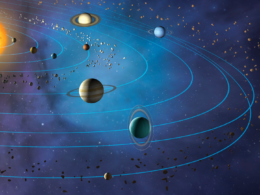Comets are pretty weird, when you think hard about them; these icy bodies come in two varieties: long-period or short-period. Short-period comets usually come from somewhere within the Kuiper Belt, a belt of rocky objects—really remnants of the initial formation of the Solar System some 4.5 billion years ago—staying outside Neptune’s orbit, some 30 AU (astronomical units; the distance from the Earth to the Sun, which is about 150 million km (93 million mi)) away. Long-period comets, on the other hand, come from much farther away in the Oort Cloud—said to be a cloud of icy bodies like the Kuiper Belt, only this time they’re almost ten times as far from the Sun, ranging from 2,000 to 200,000 AU.
What really separates comets from other planet-hopefuls like asteroids is the presence of a gravitationally-unbound atmosphere created by volatile gases locked inside their bodies. These volatiles escape the comet as it heats up while approaching the Sun. This approach also causes some ice on its body to melt. Given the fact that most comets are just loose particles of ice, dust, and rocks bound together by gravity, this approach to the inner Solar System causes these particles to stream out of its body together with the volatile gases, creating the iconic “tail” comets are perhaps best known for.
The smallest comet we’ve visited “personally” is the Comet Hartley 2, designated 103P/Hartley. Visited by the Deep Impact spacecraft back in 2010, the comet measured at only 1.2 to 1.6 km (0.75 to 1 mi) wide. The famous Halley’s Comet, designated 1P/Halley, is “only” 15 km (9 mi) at its widest.
The largest we’ve ever found, though, is the Bernardinelli-Bernstein Comet, designated the name C/2014 UN271 (Bernardinelli-Bernstein) which just rolls off the tongue. The C in its name means the comet is nonperiodic, meaning these comets either do not orbit the Sun, or take an extraordinarily long time to do so.
This particular comet is a staggering 150 km (93 mi) wide—one-third the length of the Grand Canyon, and five and a half times longer than Olympus Mons is tall—Mars’ tallest mountain and the tallest overall in the Solar System. This comet beats out the previous record-holder, C/1729 P1, also known as Sarabat’s Comet; calculations place it as potentially being the brightest comet ever seen in the sky when it passed back in 1729, which astronomers associate with it having a diameter of around 100 km (62 mi).
The Bernardinelli-Bernstein Comet was actually first identified back in 2014 (hence its designation), but was formally recognized just this year; it was discovered by its two namesake discoverers, astronomers Pedro Bernardinelli and Gary Bernstein.
This comet appears to be in for the long haul. Its most distant point calculated, some 40,400 AU away, was its position some 1.5 million years ago; it’s set to peak in its current trajectory, approaching Saturn’s orbit at a distance of about 10.9 AU, at around 2031. The last time this gigantic comet was around was some 3.5 million years ago, where it came within 18 AU of the Sun.
Scientists have calculated that its comet tail may consist of gases like carbon dioxide (CO2) and ammonia (NH3), and that it might brighten a little in the night sky in the future, at just a little bit dimmer than what Saturn’s moon Titan appears as now.
The findings on this comet have yet to be published, but it is available for viewing in preprint on arXiv.
(For more oddities in the sky, here’s news about an odd supernova that appeared in three spots in the sky at once; also, here’s our look at the James Webb Space Telescope, set to be our clearest set of eyes to the sky yet once it launches later this year.)
References
- Bernardinelli, P. H., Bernstein, G. M., Montet, B. T., Weryk, R., Wainscoat, R., Aguena, M., Allam, S., Andrade-Oliveira, F., Annis, J., Avila, S., Bertin, E., Brooks, D., Burke, D. L., Rosell, A. C., Kind, M. C., Carretero, J., Cawthon, R., Conselice, C., Costanzi, M., … Zhang, Y. (2021). C/2014 UN271 (Bernardinelli-bernstein): The nearly spherical cow of comets. ArXiv:2109.09852 [Astro-Ph]. http://arxiv.org/abs/2109.09852
- Irving, M. (2021a, June 21). Extremely eccentric minor planet to visit inner solar system this decade. New Atlas. https://newatlas.com/space/2014-un271-comet-solar-system-close-pass/
- Irving, M. (2021b, September 30). Astronomers size up biggest-known comet as it approaches solar system. New Atlas. https://newatlas.com/space/c2014-un271-bernardinelli-bernstein-largest-comet/
- Wall, M. (2010, November 4). Comet hartley 2 gets visit from deep impact spacecraft. Space.Com. https://www.space.com/9465-comet-hartley-2-visit-deep-impact-spacecraft.html











